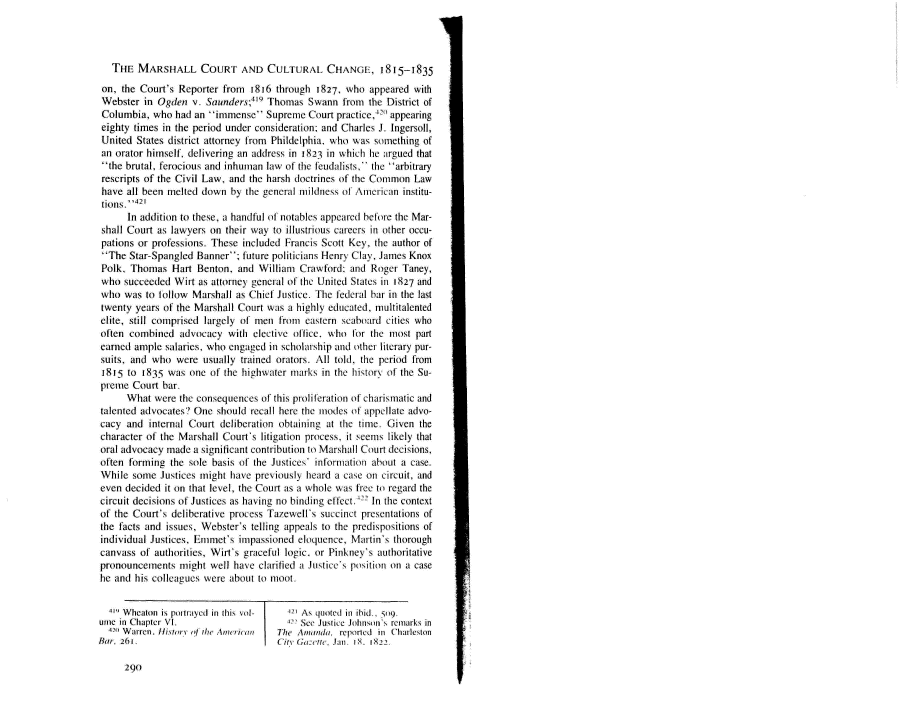|
THE MARSHALL COURT AND CULTURAL CHANGE, 1815-1835
on, the Court's Reporter from 1816 through 1827, who appeared with
Webster in Ogden v. Sounders;41"* Thomas Swann from the District of
Columbia, who had an "immense" Supreme Court practice,420 appearing
eighty times in the period under consideration; and Charles J. Ingersoll,
United States district attorney from Phildelphia, who was something of
an orator himself, delivering an address in 1823 in which he argued that
"the brutal, ferocious and inhuman law of the feudalists," the "arbitrary
rescripts of the Civil Law, and the harsh doctrines of the Common Law
have all been melted down by the general mildness of American institu-
tions."421
In addition to these, a handful of notables appeared before the Mar-
shall Court as lawyers on their way to illustrious careers in other occu-
pations or professions. These included Francis Scott Key, the author of
"The Star-Spangled Banner"; future politicians Henry Clay, James Knox
Polk, Thomas Hart Benton, and William Crawford: and Roger Taney,
who succeeded Wirt as attorney general of the United States in 1827 and
who was to follow Marshall as Chief Justice. The federal bar in the last
twenty years of the Marshall Court was a highly educated, multitalented
elite, still comprised largely of men from eastern seaboard cities who
often combined advocacy with elective office, who for the most part
earned ample salaries, who engaged in scholarship and other literary pur-
suits, and who were usually trained orators. All told, the period from
1815 to 1835 was one of the highwater marks in the history of the Su-
preme Court bar.
What were the consequences of this proliferation of charismatic and
talented advocates? One should recall here the modes of appellate advo-
cacy and internal Court deliberation obtaining at the time. Given the
character of the Marshall Court's litigation process, it seems likely that
oral advocacy made a significant contribution to Marshall Court decisions,
often forming the sole basis of the Justices" information about a case.
While some Justices might have previously heard a case on circuit, and
even decided it on that level, the Court as a whole was free to regard the
circuit decisions of Justices as having no binding effect.422 In the context
of the Court's deliberative process Tazewell's succinct presentations of
the facts and issues, Webster's telling appeals to the predispositions of
individual Justices, Emmet's impassioned eloquence, Martin's thorough
canvass of authorities, Wirt's graceful logic, or Pinkney's authoritative
pronouncements might well have clarified a Justice's position on a case
he and his colleagues were about to moot.
4I<) Whcaton is portrayed in this vol-
ume in Chapter VI.
42o Warren, History of the American
Bar, 261.
421 As quoted in ibid., 509.
'- See Justice Johnson's remarks in
The Annunlci, reported in Charleston
Cit\ Caicuc, Jan. 18. 1822.
|

